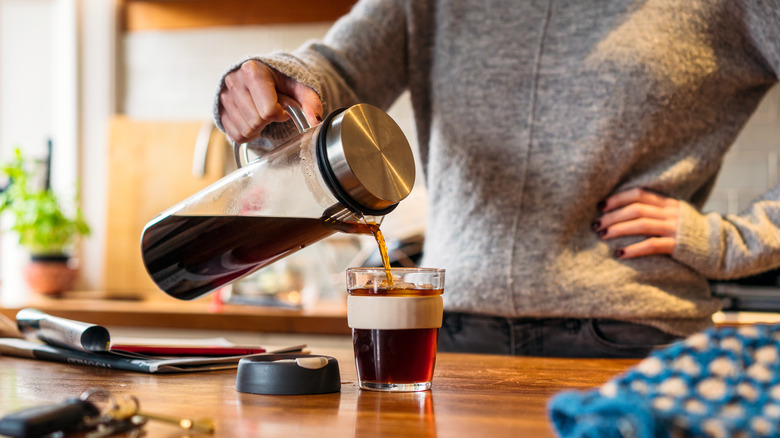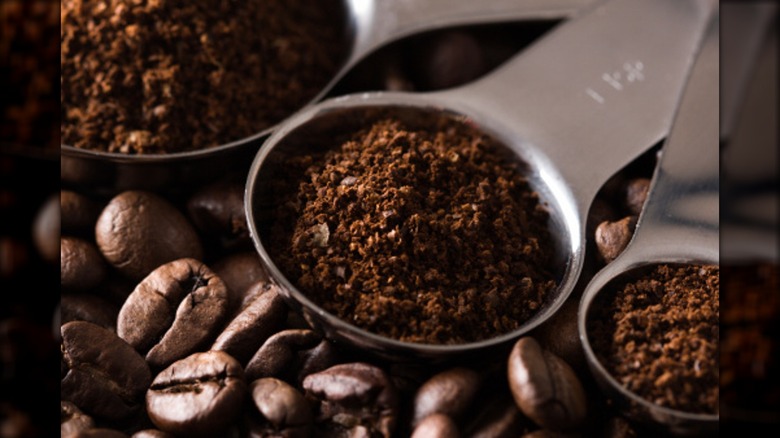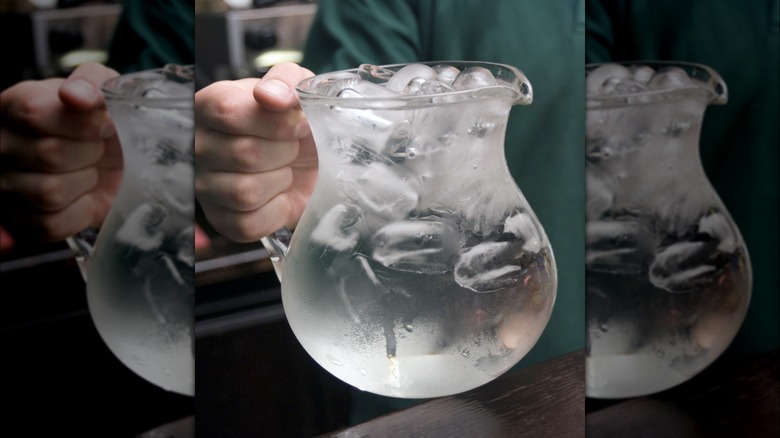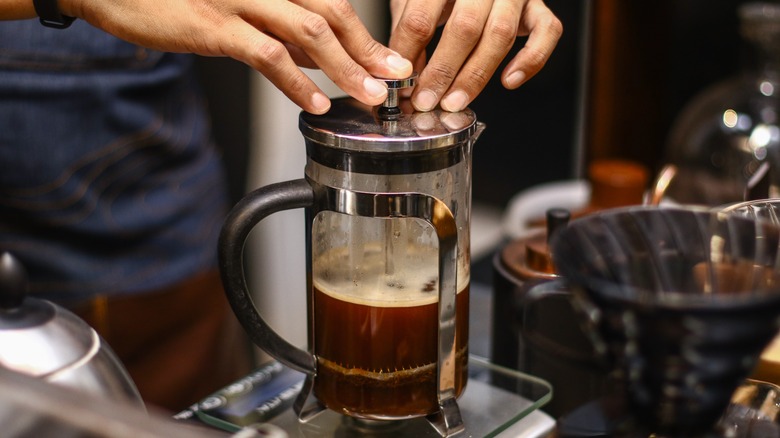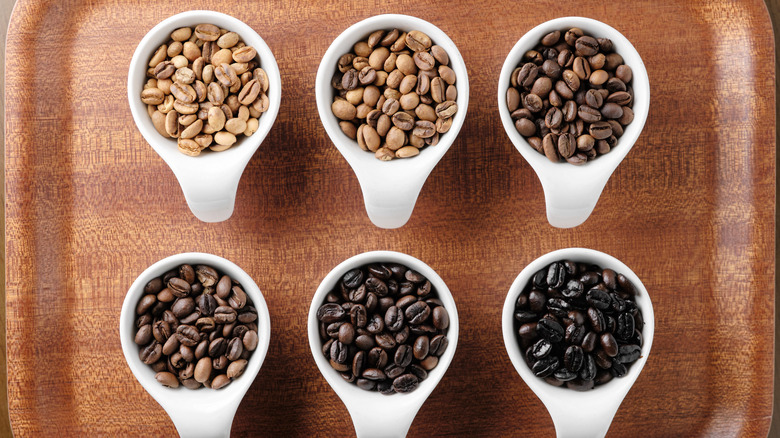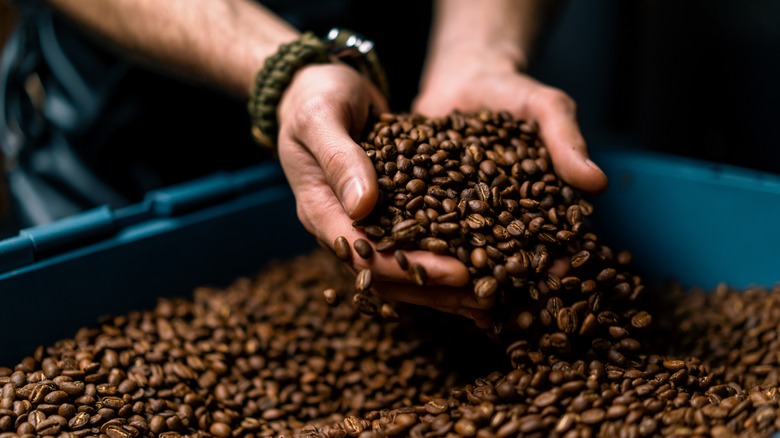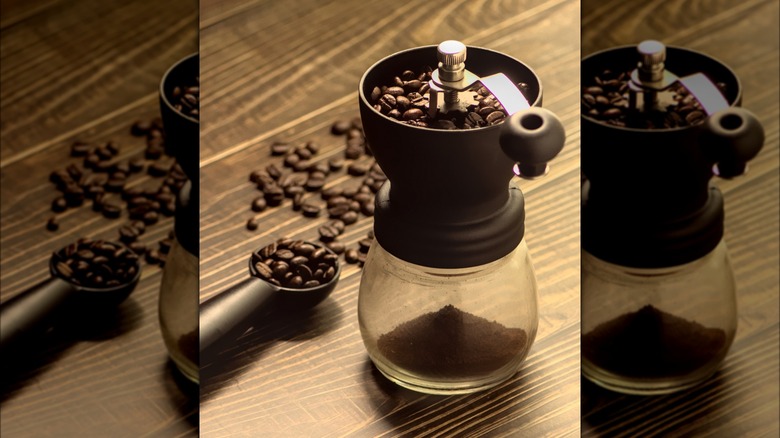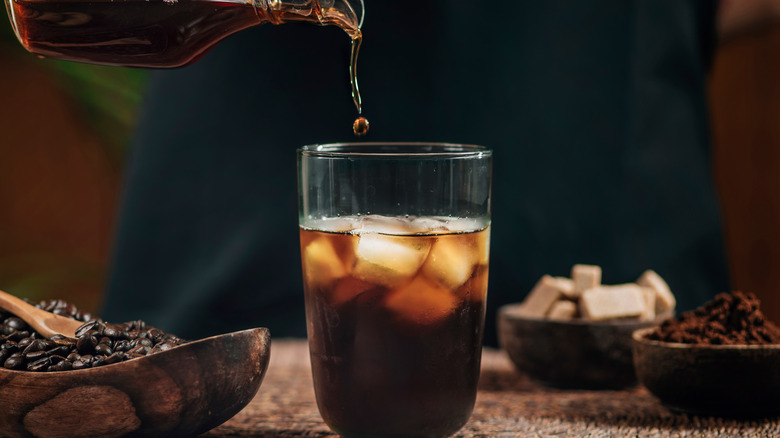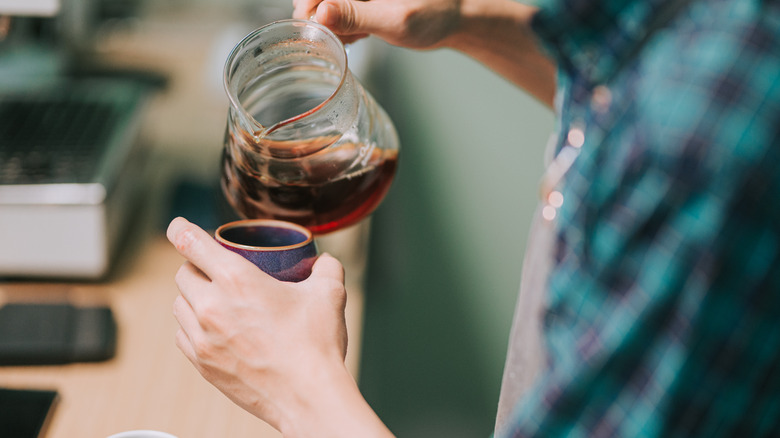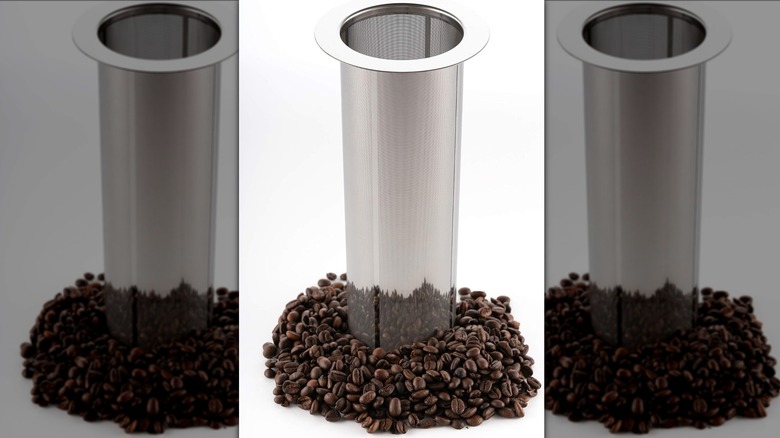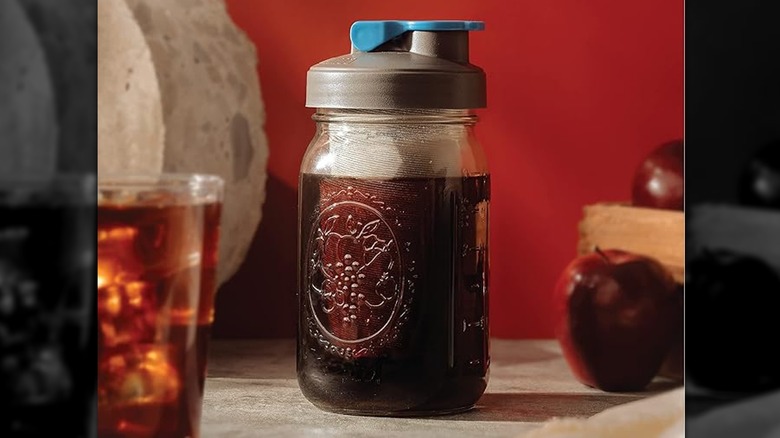10 Mistakes Everyone Makes With Homemade Cold Brew, According To An Expert Barista
We may receive a commission on purchases made from links.
While traditional coffee is made using hot water, cold brew is different. Instead, the coffee grounds are steeped in cool water for several hours. This technique results in a cup of joe with a milder, less acidic, taste than coffee brewed using hot water — even if the same coffee beans are used. If you enjoy cold brew coffee and want to stop annoying your barista by ordering it every day (and save some money while you're at it), now may be the perfect time to start making your own. You'll only need a few gadgets to make great home-brewed coffee, and it isn't all that complicated. However, while making cold brew doesn't require an advanced degree, there are still some common mistakes people often make when preparing this caffeinated beverage.
To help us understand where some individuals go wrong when making homemade cold brew, we reached out to coffee expert Matt Woodburn-Simmonds, the owner of Home Coffee Expert. Woodburn-Simmonds shared a few of the more common mistakes and some expert advice to avoid falling victim to these errors the next (or first) time you try to make cold brew.
1. Choosing the wrong grind size
If you want your cold brew to turn out right, then your coffee beans must be ground to the ideal size. A common mistake many people make is using a grind that is too coarse. Woodburn-Simmonds cautions, "The wrong grind size will result in either a sour and watery cold brew, if it's too coarse, or a very bitter brew if it's too fine."
Instead, Woodburn-Simmonds recommends a coarse-to-medium grind for brewing your ideal cup of cold brew that will yield a balanced flavor profile. He explains, "If you're thinking about a scale of 1-10, with 1 being the finest and 10 being the coarsest, then around a 7 would be ideal." If you've had a bad experience making cold brew, and it didn't turn out as desired, you may need to adjust the grind time. If the coffee you made was too sour, then you likely started with a grind that was too coarse. Try a finer grind next time. Conversely, if the cold brew was overly bitter, you may have gone too fine with your grind size. Next time, experiment with a coarse grind. Ultimately, it's about finding the right balance and a grind size that suits your taste.
2. Using water that is too cold or too hot
One mistake many people make when preparing cold brew is starting with water that is too cold. Despite its name, cold brew coffee is not made with ice-cold or refrigerator-temperature water. Instead, as Woodburn-Simmonds explains, "Cold brew is actually best when brewed at around 68 [degrees Fahrenheit]." As a reference, this is around room temperature. If the water you use is too cold, it won't extract enough of the coffee flavor, and you'll be left with a diluted and uninteresting cup of cold brew.
While you don't want the water to be too cold, it shouldn't be too hot. Woodburn-Simmonds says, "If you're using water that is too hot then you'll extract too much acidity and not have the super mellow taste we want." While it is a balancing act, room-temperature water is pretty easy to gauge. Consider leaving the correct amount of water out on the counter for a few hours before you're ready to make your coffee. So, once you are ready to begin, the water will be the ideal temperature for a perfectly-brewed cup of cold brew.
3. Not steeping the coffee for long enough
If you're used to making hot coffee, you probably already know how important the brew time is. If you leave the coffee grounds brewing too long, the result will be a bitter brew. Don't let it brew long enough, it will be a bland cup. "Cold brew is no different, it's just the brewing time is measured in hours rather than minutes or seconds," says Matt Woodburn-Simmonds.
The general rule for making cold brew, especially for those new to the process, is to aim for an 8-hour brew time (remember that the water must be at room temperature). Many adults get around 8 hours of sleep every night, so you can likely get your cold brew started right before bed to have it ready to enjoy when you wake up. As you get more comfortable making cold brew and want to experiment with the flavor, Woodburn-Simmonds shares, "you can adjust the temperature and grind size and steep for up to 24 hours to get super sweet and mellow coffee."
4. Using the wrong roast level
If you have a favorite roast level for making hot brew coffee, it may or may not end up being the best fit for cold brew. Not all roast levels are ideal for cold brew. "Cold brew reduces the amount of acidity in the finished drink," explains Matt Woodburn-Simmonds, so "lighter roasts that rely on that acidity to balance the fruit notes don't work so well." Unless you prefer a more acidic beverage, save your light roast coffee beans for the next time you make a hot brew.
Fortunately, this mistake offers a simple fix: Switch to dark roasts when preparing cold brew. Woodburn-Simmonds explains why dark roasts are the ideal pick for cold brew. He says, "A nice dark roast will have sweet chocolate and spice notes with the reduced acidity making it taste extra smooth." Now, that's a cup of cold brew you should enjoy sipping.
5. Using old and stale coffee beans
How old are the coffee beans you're using to make cold brew? If they've been in your pantry for a while, then you've just identified another mistake you've been making. If you use stale beans, don't be surprised if your cup of cold brew tastes unappetizing. Matt Woodburn-Simmonds recommends getting "the best, freshest beans for the best-tasting cold brew." He adds, "Around 1-2 weeks off the roast is the best for maximum flavor."
If you've been stocking up on coffee beans, it is time to change your habits so your cold brew starts tasting as good as it can. You can tell your beans are stale just by smelling them. If you detect a cardboard or musty smell, it's time to add a few minutes to your weekly (or bi-weekly) schedule to pick up freshly roasted beans. Trust us. Your taste buds will thank you when they taste the difference in cold brew prepared from freshly roasted beans.
6. Not grinding the coffee right before brewing
Just as you shouldn't stock up on coffee beans, you shouldn't grind them too much ahead of time. "All the delicious volatile oils in the coffee beans evaporate within 40 minutes of grinding," explains Matt Woodburn-Simmonds. Always grind the beans just before you plan on steeping your cold brew, and you won't miss out on the flavor these oils infuse into your coffee.
For this reason, you should also avoid using pre-ground or store-bought coffee — or instant coffee — when making cold brew at home. These options can't match the flavor you'll experience compared to the beans you grind at home. If you don't have a burr grinder yet, now would be the right time to invest in one. Burr grinders are superior to blade grinders because they use two abrasive surfaces – one spinning and one static — as opposed to spinning blades. The result is a much more consistent grind. Using a burr grinder will help you avoid making common coffee grinding mistakes and ensure that the cup of cold brew you make tastes incredible.
7. Not using mineral water
We've already explained that the cold brew won't turn out right with coffee grounds that are too old or have lost their volatile oils. Well, coffee grounds are only one part of the equation for making cold brew. You also need water. And, using the wrong water can also have a profound impact on how your coffee ends up tasting. Matt Woodward-Simmonds explains, "Depending on where you live, you may have great water for brewing coffee coming straight out of the faucet. But generally, you'll want to use mineral water."
If you're not familiar with mineral water, it is water sourced from reservoirs beneath the surface of the Earth. The water doesn't require the addition of any chemicals to clean it or make it safe to drink. It is also high in calcium, magnesium, sodium, and other minerals. If your tap water doesn't taste quite right, it isn't going to make a good cold brew.
8. Not using the proper ratio of water to coffee
Beyond starting with water that won't alter the taste of your coffee, there is another water-related mistake you will want to avoid when making cold brew. Make sure your ratio of water to coffee is correct as this is essential to producing a balanced brew. The ideal ratio of water to coffee can vary depending on whether you prefer to make a standard or concentrated cold brew.
Standard cold brew is ready to drink; you don't need to do anything to dilute it. Matt Woodburn-Simmonds says, "1 part coffee to 8 parts water will yield coffee you drink as is." He adds, "If you'd like to make coffee concentrate to dilute with water or milk then a 1:4 or even 1:2 ratio will get you the best results." Everyone's tastes and preferences are slightly different, so some experimentation may help find the ideal ratio for you.
9. Brewing without a coffee filter
You wouldn't try to make drip coffee without a filter, would you? Well, you shouldn't make the mistake of trying to prepare cold brew without a filter either. So, after your cold brew has finished steeping in the fridge, you'll need to remove the coffee grounds before you drink it. As Matt Woodburn-Simmons notes, "You need to make sure you filter all the coffee grounds out of your cold brew before storing it so extraction doesn't continue." If you don't use a filter and the extraction continues, the cold brew will likely become too bitter to be enjoyable.
In a pinch, you could use a tea strainer to make your cold brew, but Woodburn-Simmonds advises against this approach because it won't yield the best cold brew possible. Instead, invest in a coffee filter or bag specifically designed for cold brew. Woodburn-Simmonds says doing so will help you make "the clearest cold brew coffee that won't continue to extract and go bitter." If you don't have a traditional coffee filter then a cheesecloth Is also a good alternative.
10. Not storing the cold brew properly
Many people make a large batch of cold brew to last several days. While nothing is inherently wrong with this, you should learn how to store it properly to maintain the optimal taste. According to Matt Woodburn-Simmonds, "If you store it incorrectly then it will oxidize and taste stale and flat."
One mistake people make is storing their cold brew in an open container or without a proper seal. Use an airtight container to avoid the oxidation and flat, stale taste that Woodburn-Simmonds warns against. When you use an airtight container, the cold brew can last for up to a month. You could also freeze it for up to two months. If possible, opt for a glass container over a plastic one. It won't impact the taste of the cold brew. Plus, once you've used up the coffee, clean-up will be easier because glass doesn't stain like plastic. One more tip for proper storage: Don't add any milk or sugar until you're ready to drink the coffee. This will reduce the amount of time you can store it in the fridge to two to three days.
